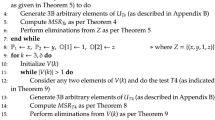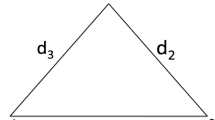Abstract
This paper contains two results on influence in collective decision games. The first part deals with general perfect information coin-flipping games as defined in [3].Baton passing (see [8]), ann-player game from this class is shown to have the following property: IfS is a coalition of size at most\(\frac{n}{{3\log n}}\), then the influence ofS on the game is only\(O\left( {\frac{{\left| S \right|}}{n}} \right)\). This complements a result from [3] that for everyk there is a coalition of sizek with influence Ω(k/n). Thus the best possible bounds on influences of coalitions of size up to this threshold are known, and there need not be coalitions up to this size whose influence asymptotically exceeds their fraction of the population. This result may be expected to play a role in resolving the most outstanding problem in this area: Does everyn-player perfect information coin flipping game have a coalition ofo(n) players with influence 1−o(1)? (Recently Alon and Naor [1] gave a negative answer to this question.) In a recent paper Kahn, Kalai and Linial [7] showed that for everyn-variable boolean function of expectation bounded away from zero and one, there is a set of\(\frac{{n\omega (n)}}{{\log n}}\) variables whose influence is 1−o(1), wherew(n) is any function tending to infinity withn. They raised the analogous question where 1−o(1) is replaced by any positive constant and speculated that a constant influence may be always achievable by significantly smaller sets of variables. This problem is almost completely solved in the second part of this article where we establish the existence of boolean functions where only sets of at least\(\Omega \left( {\frac{n}{{\log ^2 n}}} \right)\) variables can have influence bounded away from zero.
Similar content being viewed by others
References
N. Alon, andM. Naor: Coin-flipping games immune against linear-sized coalitions, FOCS 1990, 46–54, to appear inSIAM J. on Computing.
N. Alon, andJ.H. Spencer:The Probabilistic Method, Wiley-Interscience Publication, John Wiley and Sons, 1992.
M. Ben-Or, andN. Linial: Collective coin flipping, in: Randomness and Computation (S. Micali ed.) Academic Press, New York, 1990, 91–115.
M. Ben-Or, N. Linial, andM. Saks: Collective coin flipping and other models of imperfect randomness, in:Combinatorics (Eger 1987), Colloq, Math Soc. János Bolyai52, 75–112.
B. Bollobás:Random Graphs, Academic Press, 1982.
H. Chernoff: A measure of asymptotic efficiency for tests of hypothesis based on the sum of observations,Ann. Math. Stat. 23 (1952), 493–507.
J. Kahn, G. Kalai, andN. Linial: The influence of variables on Boolean functions,FOCS (1988) 68–80.
M. Saks: A robust non-cryptographic protocol for collective coin flipping,SIAM J. Disc. Math. 2 (1989) 240–244.
Author information
Authors and Affiliations
Additional information
Work supported in part by grants from the Binational Science Foundation Israel-US and the Israeli Academy of Science.
Rights and permissions
About this article
Cite this article
Ajtai, M., Linial, N. The influence of large coalitions. Combinatorica 13, 129–145 (1993). https://doi.org/10.1007/BF01303199
Received:
Revised:
Issue Date:
DOI: https://doi.org/10.1007/BF01303199




